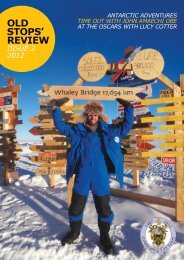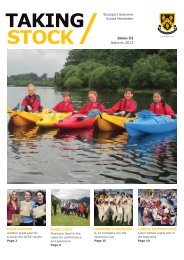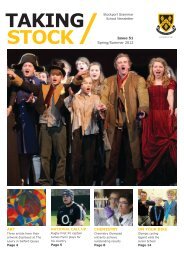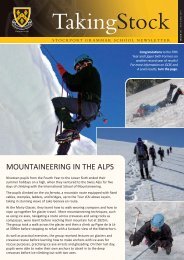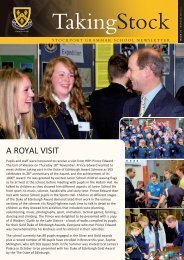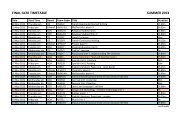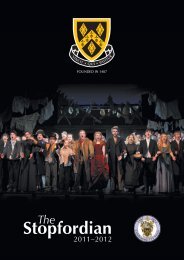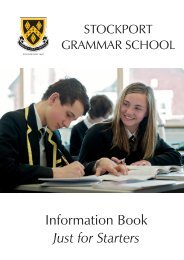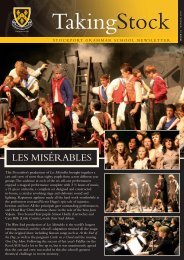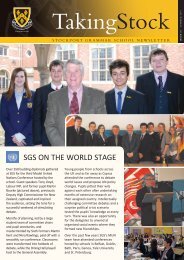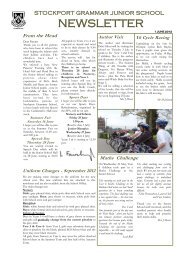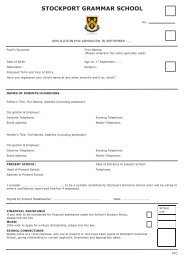Stopfordian 2010â2011 - Stockport Grammar School
Stopfordian 2010â2011 - Stockport Grammar School
Stopfordian 2010â2011 - Stockport Grammar School
You also want an ePaper? Increase the reach of your titles
YUMPU automatically turns print PDFs into web optimized ePapers that Google loves.
The <strong>Stopfordian</strong> 2010–2011<br />
AUTHOR VISIT: JACKIE MORRIS<br />
The author and illustrator Jackie Morris visited the school on<br />
Tuesday 5th October to talk to the Juniors and Infants about<br />
her work.<br />
BIOGRAPHY<br />
Jackie was born in Birmingham and from the age of six she<br />
knew she wanted to be an artist. She watched her father<br />
drawing a picture of a bird and thought it was magical to see<br />
the image appear.<br />
She spent three years at Bath Academy of Art and then set off<br />
for London to work as an illustrator. She has won numerous<br />
awards and her work has been exhibited widely in galleries<br />
throughout the UK and as far afield as Australia. She has work<br />
in the public collection at the National Library of Wales.<br />
Jackie lives in Pembrokeshire, Wales, has two children, three<br />
dogs and more cats than she can count.<br />
THE PRESENTATIONS<br />
Jackie spoke to the Infants about her book, ‘Tell me a Dragon’.<br />
Whilst she read the text the children were enthralled with<br />
images from the pages of the book that were displayed on the<br />
screen. The timetable for the rest of the day was suspended<br />
as the children were desperate to write about their own<br />
dragons and had vivid ideas as to their names, appearance<br />
and characteristics.<br />
A similar scenario unfolded in the afternoon when the Juniors<br />
were held spell bound by her book ‘The Ice Bear’. The story<br />
was poignant and the illustrations were breathtaking. The<br />
children had a magical day – just what education should be all<br />
about.<br />
J. Mercer<br />
YEAR 6 ART DAY<br />
At the beginning of the workshop we looked at some ways<br />
animals have been painted in various cultures from Jeff’s<br />
collection of art postcards. These ranged from the Lineas de<br />
Nasca Uca in Peru (the desert line-drawings), wooden fire<br />
sculptures by Phil Bews (The Phoenix), and drawings by Picasso.<br />
Juxtaposed to a realistic painting of a lion by Sir Edwin<br />
Landseer (1849) was a painting by Australian artist Djambu<br />
Barra Barra of a kangaroo (1999). The pupils also looked at<br />
cave paintings of animals, a wire ‘flock of sheep’by Sophie<br />
Ryder, a fibre glass maquette for King Kong by Nick Monro,<br />
paintings and drawings by the Tinga Tinga tribe in Africa,<br />
particularly by artist Jaribuni of a leopard, next to an 8 th<br />
Century drawing of a lion from the Book of Durrow (Trinity<br />
College Dublin), an equestrian statue in Madrid, and finally a<br />
series of modern Aboriginal paintings of animals.<br />
The pupils then worked from a variety of pictures of animals,<br />
birds, insects and reptiles (one for each group), drawing first<br />
very large in pencil to fill an A3 sheet. These were then<br />
worked over in ball point pen to increase the power and<br />
visibility of the drawing, which were then stained with<br />
coloured inks – generally dark blue or green for the<br />
background, and yellow/red for the animal. This ‘undercoat’<br />
was then worked into with the dot technique of the Aborigine<br />
artists, using cotton buds dipped into acrylic paints. It was<br />
important that the dots were placed close together so that the<br />
runs of dots created lines and patterns dictated by the outline<br />
of the shape of the chosen animal and the patterns seen<br />
within them.<br />
The pupils worked hard during the day but every child left the<br />
workshop feeling proud of their achievements and looking<br />
forward to continuing the process in the weeks ahead.<br />
J. Mercer<br />
YEAR 5 ART DAY<br />
The aim of this workshop was to encourage observational<br />
drawing, enlarging the image, layering of materials, and an<br />
introduction of the batik process.<br />
Each group was given a collection of different leaves – laurel,<br />
holly and Oregon grape – and they began the session by looking<br />
at the work of Georgia O’Keeffe through a book and collection<br />
of postcards. On A3 paper, the small leaf had to be enlarged to<br />
fill the paper, in itself quite a difficult task for the pupils. They<br />
used pencil first, and overlaid the ‘correct’ lines with ball point<br />
pen, then erasing any errors.<br />
Then came the wax layering, starting always with the lightest<br />
colour, yellow, and overlaying this with subsequent colours, i.e.<br />
green or orange to obtain a richer ‘green ’or ‘orange’ than could<br />
be obtained by the simple use of the colour itself. Because wax<br />
is a transparent medium, the pen drawing was still visible. After<br />
this layer, other layers, such as reds and blues were carefully<br />
applied to darken or enrich the colours and, in this case, leaving<br />
the veins of the leaves yellow.<br />
Next was the process to ‘distress’ the paper by crumpling it up<br />
and then carefully flattening it out again, taking care not to tear<br />
the creased paper. The creases fractured the paper surface and<br />
also the layers of wax. They then stained their work with inks –<br />
106 Junior <strong>School</strong>



